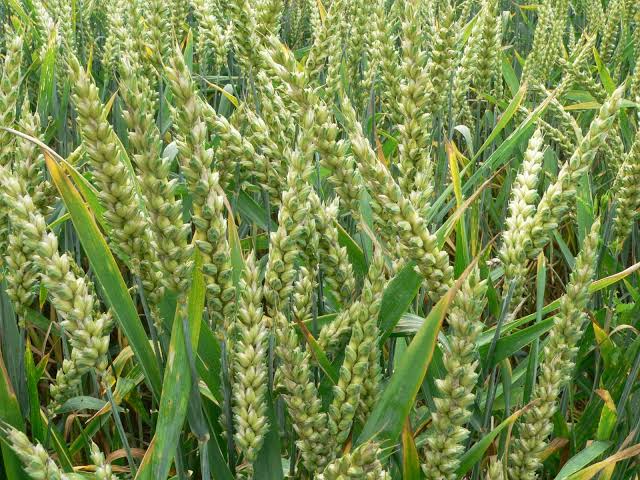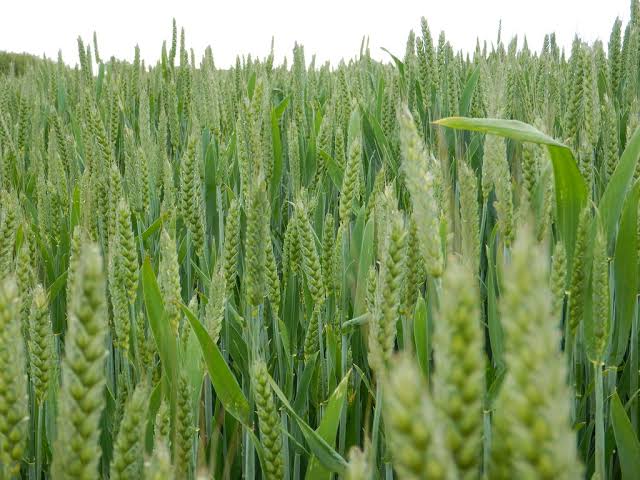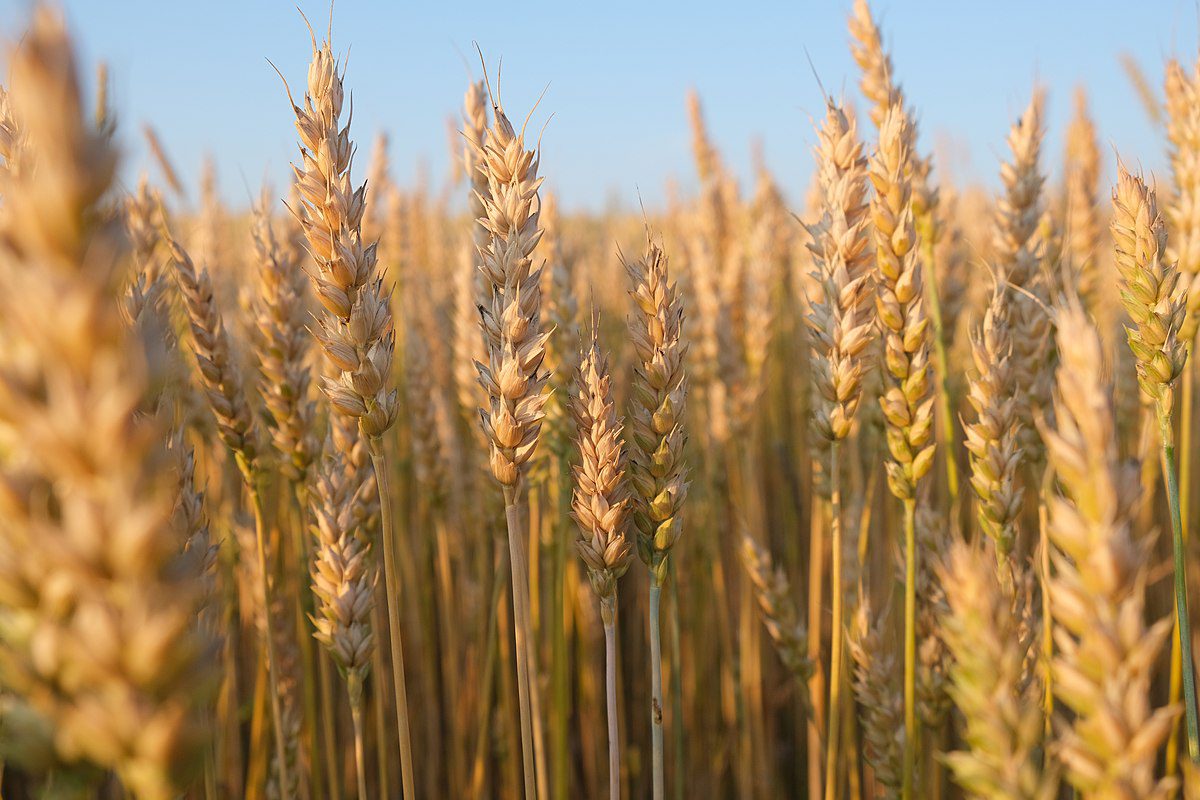Wheat (Triticum spp.) is a crucial cereal grain that plays a vital role in global agriculture and human nutrition. Belonging to the grass family Poaceae, wheat is cultivated worldwide, making it one of the most widely grown and consumed crops.
This versatile grain is a staple food for a significant portion of the world’s population, providing a substantial source of dietary energy. Its adaptability to various climates and soils has contributed to its widespread cultivation, with different varieties suited to diverse environmental conditions.
Wheat grains are the edible seeds of the wheat plant, and they come in different shapes and sizes depending on the specific variety. The most common types of wheat include durum wheat, used in pasta production, and bread wheat, favored for making various types of bread.
In terms of nutritional content, wheat is a rich source of carbohydrates, particularly starch, which serves as a primary energy source for the human body. Additionally, wheat contains essential vitamins and minerals, such as B-vitamins, iron, and magnesium, contributing to overall health and well-being.
The cultivation of wheat has a long history, dating back thousands of years. It is believed to have originated in the Fertile Crescent, an area encompassing parts of modern-day Iraq, Syria, Lebanon, Israel, and Jordan. Over time, wheat cultivation spread across different regions, becoming a cornerstone of various civilizations.
Wheat is typically grown as a winter or spring crop, depending on the climatic conditions of a particular region. The planting and harvesting processes are carefully managed to ensure optimal yield and quality. Modern agricultural practices, including the use of machinery and advanced technologies, have significantly increased wheat production efficiency.
The versatility of wheat extends beyond its use as a staple food. It is also a key ingredient in the production of various food products, including flour, pasta, couscous, and breakfast cereals. Wheat straw, a byproduct of wheat cultivation, is utilized for animal bedding, thatching, and as a raw material in some industrial processes.
Despite its widespread cultivation and consumption, wheat faces challenges such as susceptibility to pests, diseases, and environmental factors. Ongoing research and technological advancements aim to develop more resilient wheat varieties, ensuring sustained production and food security in the face of evolving agricultural landscapes.
In addition, Wheat (Triticum spp.) stands as a fundamental and versatile crop with a rich history deeply intertwined with human civilization. Its nutritional value, adaptability, and various applications make it an indispensable component of global agriculture and dietary habits.
Read Also: The Benefits of a Zoo
How To Grow Wheat (Triticum spp.)

Growing wheat (Triticum spp.) involves a series of steps that require attention to detail and adherence to certain agricultural practices. Here’s a basic guide on how to grow wheat:
1. Site Selection: Choose a well-drained field with fertile soil. Wheat prefers loamy soils with good moisture retention. Ensure the selected area receives ample sunlight.
2. Soil Preparation: Prepare the soil by plowing and harrowing to create a fine seedbed. Remove any weeds or debris that may hinder the growth of the wheat plants.
3. Seed Selection: Choose high-quality, disease-resistant wheat seeds suitable for your region. The choice of wheat variety depends on factors like climate, soil type, and intended use (bread, pasta, etc.).
4. Planting: Plant the seeds at the right time, considering the wheat variety and the local climate. Generally, wheat is planted in the fall (winter wheat) or early spring (spring wheat). Use a seed drill to ensure even distribution.
5. Spacing: Maintain proper row spacing and seed depth. Adequate spacing allows for better air circulation, reducing the risk of diseases. Plant the seeds at a depth of about 1 to 2 inches.
6. Fertilization: Apply fertilizer based on soil test results. Wheat requires nitrogen, phosphorus, and potassium for optimal growth. The application rates may vary depending on the stage of growth.
7. Irrigation: Ensure proper irrigation throughout the growing season. Wheat requires consistent moisture, especially during critical stages like germination and grain filling. However, avoid waterlogging, as it can lead to root diseases.
8. Weed Control: Implement effective weed control measures, as weeds can compete with wheat for nutrients and sunlight. Herbicides or manual weeding can be employed, depending on the scale of cultivation.
9. Disease and Pest Management: Monitor the crop regularly for signs of diseases and pests. Fungal diseases and insects like aphids can affect wheat. Use appropriate fungicides or insecticides if necessary.
10. Growth Monitoring: Keep an eye on the growth stages of the wheat crop. Be prepared to apply additional nutrients if deficiencies are observed during the growing season.
11. Harvesting: Harvest the wheat when it reaches maturity. This is typically when the crop changes color, and the grains are hard and dry. Harvesting can be done using a combine harvester.
12. Drying and Storage: Dry the harvested wheat to reduce moisture content. Properly store the grains in well-ventilated containers or silos to prevent mold and insect infestations.
By following these steps, you can cultivate a healthy and productive wheat crop. Keep in mind that local conditions and specific wheat varieties may require adjustments to these general guidelines.
How To Care For Wheat (Triticum spp.)
Caring for wheat (Triticum spp.) involves a combination of practices aimed at promoting healthy growth, preventing diseases, and optimizing yield. Here’s a guide on how to care for wheat:
1. Monitor Growth Stages: Regularly monitor the growth stages of the wheat crop. Understanding the developmental phases helps in implementing timely care practices.
2. Watering: Ensure consistent and adequate irrigation, especially during critical growth stages such as germination, flowering, and grain filling. Wheat requires sufficient moisture, but it’s crucial to avoid waterlogging.
3. Fertilization: Apply fertilizers based on soil nutrient levels and the specific needs of the wheat variety. Nitrogen is particularly important for wheat, and timely applications at key growth stages can enhance yield.
4. Weed Management: Control weeds to minimize competition for nutrients, water, and sunlight. Implement pre-emergence and post-emergence weed control strategies, either through herbicides or manual weeding, depending on the scale of cultivation.
5. Disease Prevention: Monitor the crop for signs of diseases, such as rust and powdery mildew. Consider using disease-resistant wheat varieties and apply fungicides preventatively if necessary. Crop rotation and proper spacing can also reduce the risk of diseases.
6. Pest Control: Keep an eye out for pests like aphids and wireworms. Use integrated pest management techniques, including beneficial insects and insect-resistant wheat varieties, to minimize the impact of pests.
7. Crop Rotation: Practice crop rotation to break pest and disease cycles. Avoid planting wheat in the same field consecutively to reduce the risk of soil-borne diseases and pests.
8. Supportive Weather Practices: Be aware of local weather conditions and adjust care practices accordingly. Extreme weather events like frost or heatwaves can impact wheat, so be prepared to implement protective measures when necessary.
9. Timely Harvesting: Harvest the wheat at the right time to prevent yield loss. Harvesting too early or too late can affect the quality and quantity of the crop. Monitor the crop closely as it approaches maturity.
10. Post-Harvest Care: Properly dry the harvested wheat to reduce moisture content and prevent mold. Store the grains in suitable conditions to avoid spoilage and pest infestations.
11. Soil Health Maintenance: Pay attention to soil health by practicing sustainable agricultural methods. Crop residues can be left on the field after harvest to improve soil structure and nutrient content.
12. Continuous Learning: Stay informed about the latest advancements in wheat cultivation and care practices. Attend workshops, consult with agricultural experts, and participate in extension programs to enhance your knowledge and skills.
By combining these care practices, you can promote a healthy and productive wheat crop, ensuring optimal yield and quality. Adjustments may be needed based on specific environmental conditions and local factors.
Read Also: The History and Origin of Wolves
The Uses of Wheat (Triticum spp.)

Wheat (Triticum spp.) is an incredibly versatile crop with a wide range of uses, making it a fundamental component of human diets, economies, and industries. Here are some key uses of wheat:
1. Food Production: Wheat is a major staple in human diets, providing a significant source of carbohydrates. It is used to produce a variety of food products, including bread, pasta, couscous, and breakfast cereals.
2. Flour Production: Wheat is milled to produce flour, a primary ingredient in baking. Different types of wheat, such as hard and soft varieties, are used to create various types of flour suitable for different products.
3. Noodle Manufacturing: Durum wheat, known for its high protein content and gluten strength, is specifically used in the production of pasta and noodles.
4. Breakfast Cereals: Wheat is a key ingredient in many breakfast cereals, providing a nutritious and energy-rich start to the day.
5. Animal Feed: Wheat grains and byproducts are used as animal feed, contributing to the livestock and poultry industries.
6. Brewing Industry: Some varieties of wheat, particularly malted wheat, are used in the brewing industry to produce beer. Wheat beer is known for its distinct flavor.
7. Ethanol Production: Wheat can be utilized in the production of biofuels, such as ethanol, contributing to renewable energy sources.
8. Straw for Various Applications: Wheat straw, a byproduct of wheat cultivation, is used for animal bedding, thatching roofs, and as raw material in papermaking and some industrial processes.
9. Cover Crop and Soil Improvement: Wheat is often used as a cover crop in rotation systems to protect soil from erosion, suppress weeds, and improve soil structure.
10. Industrial Uses: Wheat components, such as starch and gluten, are utilized in various industrial applications, including the production of adhesives, paper, and certain types of biodegradable plastics.
11. Culinary Uses: Wheat is not only a major ingredient in staple foods but is also used in a variety of culinary applications, from creating coatings for fried foods to serving as a thickening agent in sauces.
12. Seed Reproduction: Wheat grains serve as the seeds for the next crop cycle, contributing to the ongoing cultivation of this essential cereal grain.
The widespread adoption of wheat in diverse sectors highlights its importance to global agriculture and economies. Its adaptability, nutritional value, and versatility make it a crucial crop that continues to play a central role in meeting the nutritional needs of people worldwide.
Frequently Asked Questions (FAQs)
Q: What are the different types of wheat?
A: There are several types of wheat, including hard red wheat, hard white wheat, soft red wheat, soft white wheat, and durum wheat. Each type has unique characteristics and is suitable for specific end products.
Q: How is wheat typically planted?
A: Wheat is usually planted using a seed drill, ensuring even distribution. The planting depth is generally around 1 to 2 inches, and row spacing depends on the specific cultivation practices and equipment used.
Q: When is the best time to plant wheat?
A: The timing of planting depends on the variety of wheat and local climate. Winter wheat is typically planted in the fall, while spring wheat is planted in early spring.
Q: How long does it take for wheat to grow and be ready for harvest?
A: The growth period of wheat varies, but it generally takes around 90 to 150 days from planting to harvest. Factors such as wheat variety, climate, and planting time influence the growing duration.
Q: What are common pests and diseases affecting wheat?
A: Common pests include aphids and wireworms, while diseases like rust and powdery mildew can impact wheat. Integrated pest management and disease-resistant varieties are often used for control.
Q: How is wheat harvested?
A: Wheat is typically harvested using a combine harvester. The timing of harvest is crucial for optimal yield and quality, and it often occurs when the crop reaches maturity and the grains are dry and hard.
Q: What are the nutritional benefits of wheat?
A: Wheat is a rich source of carbohydrates, providing essential energy. It also contains B-vitamins, iron, and magnesium, contributing to overall nutritional intake.
Q: Can wheat be grown organically?
A: Yes, wheat can be grown organically. Organic wheat cultivation involves avoiding synthetic fertilizers and pesticides, relying on natural methods for pest and disease control.
Q: How is wheat used in the brewing industry?
A: Wheat, particularly malted wheat, is used in brewing to produce certain beer styles. Wheat beer is known for its unique flavor and is popular in the brewing industry.
Q: What are some alternative uses of wheat straw?
A: Wheat straw is used for animal bedding, thatching roofs, and as a raw material in papermaking. Additionally, it can be used in the production of biodegradable products and certain industrial processes.
Read Also: Rotating Biological Discs Process

